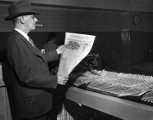Kanawha Valley Star
Place of publication: Charleston, VA [W. Va.]
The premier issue of the Star of the Kanawha Valley was published on January 1, 1855, in Buffalo, Virginia, now West Virginia. Proprietors John Rundle, William Murrell, and William Kennedy dedicated the newspaper to advocating the rights of the South but supporting no political party and to promoting economic development and internal improvements in western Virginia, particularly along the Kanawha River. The weekly publication had four pages with 28 columns per issue. In March 1855, after Kennedy's departure, Rundle and Murrell revised their original intention to remain politically neutral and shifted the Star to a position staunchly promoting and openly defending the Democratic Party, a position the paper maintained until publication ceased on July 2, 1861.
Its office was destroyed by arson sometime after August 15, 1855, but the Star resumed publishing by November 15. When Rundle became sole proprietor on July 23, 1856, he asserted that "there would be a Constitutional Union or no union" and, beginning with the November 4 issue, added the states' rights motto "State Sovereignty & A Constitutional Union" under the title. The newspaper was renamed the Kanawha Valley Star on September 30, 1856, and the printing office was moved from Buffalo to Charleston "in the first building below the courthouse."
While the Star usually endorsed the interests of eastern Virginia on issues of national significance--specifically, in supporting slavery, opposing abolition, and limiting the power of Congress, the paper's journalistic hallmark was its drive to increase the progress of industry, transportation, and the economy in general among the counties of western Virginia. The Star's writers included nearly a dozen prominent Charleston attorneys, all staunch Democrats and proponents of the states' rights ideology, which made the paper much more sectional and radical in its editorials and therefore more typical of the Southern press. Coverage of regional politics soon gave way to national issues such as the Kansas-Nebraska Act, the Emigrant Aid Society, the American or "Know-Nothing" Party, the emergence of the new Republican Party, the actions of John Brown at Harper's Ferry, and eventually, the circumstances leading to the Civil War. After the election of President Abraham Lincoln in November 1860, the Star supported the southern states' move toward secession and the establishment of the Confederacy. It denounced the convention held in Wheeling to form a loyal, unionist government for Virginia. Union forces occupied the offices of the Kanawha Valley Star after they captured Charleston in June and July 1861. John Rundle left the newspaper to join the Confederate Army, and the final issue of the Star appeared on July 2, 1861.
Provided by: West Virginia University


